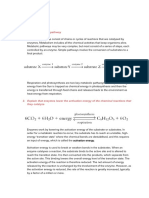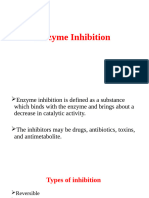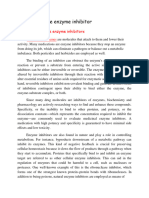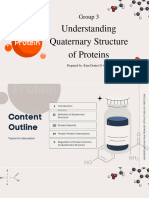Enzyme Inhibitor
Enzyme Inhibitor
Uploaded by
ACopyright:
Available Formats
Enzyme Inhibitor
Enzyme Inhibitor
Uploaded by
ACopyright
Available Formats
Share this document
Did you find this document useful?
Is this content inappropriate?
Copyright:
Available Formats
Enzyme Inhibitor
Enzyme Inhibitor
Uploaded by
ACopyright:
Available Formats
An enzyme inhibitor is a molecule that binds to an enzyme and decreases its activity.
By binding to
enzymes' active sites, inhibitors reduce the compatibility of substrate and enzyme and this leads to
the inhibition of Enzyme-Substrate complexes' formation, preventing the catalyzation of reactions
and decreasing (at times to zero) the amount of product produced by a reaction. It can be said that
as the concentration of enzyme inhibitors increases, the rate of enzyme activity decreases, and thus,
the amount of product produced is inversely proportional to the concentration of inhibitor molecules.
Since blocking an enzyme's activity can kill a pathogen or correct a metabolic imbalance, many
drugs are enzyme inhibitors. They are also used in pesticides. Not all molecules that bind to
enzymes are inhibitors; enzyme activators bind to enzymes and increase their enzymatic activity,
while enzyme substrates bind and are converted to products in the normal catalytic cycle of the
enzyme.
The binding of an inhibitor can stop a substrate from entering the enzyme's active site and/or hinder
the enzyme from catalyzing its reaction. Inhibitor binding is either reversible or irreversible.
Irreversible inhibitors usually react with the enzyme and change it chemically (e.g. via covalent
bond formation). These inhibitors modify key amino acid residues needed for enzymatic activity. In
contrast, reversible inhibitors bind non-covalently and different types of inhibition are produced
depending on whether these inhibitors bind to the enzyme, the enzyme-substrate complex, or both.
Many drug molecules are enzyme inhibitors, so their discovery and improvement is an active area of
research in biochemistry and pharmacology. A medicinal enzyme inhibitor is often judged by
its specificity (its lack of binding to other proteins) and its potency (its dissociation constant, which
indicates the concentration needed to inhibit the enzyme). A high specificity and potency ensure that
a drug will have few side effects and thus low toxicity.
Enzyme inhibitors also occur naturally and are involved in the regulation of metabolism. For
example, enzymes in a metabolic pathway can be inhibited by downstream products. This type
of negative feedback slows the production line when products begin to build up and is an important
way to maintain homeostasis in a cell. Other cellular enzyme inhibitors are proteins that specifically
bind to and inhibit an enzyme target. This can help control enzymes that may be damaging to a cell,
like proteases or nucleases. A well-characterised example of this is the ribonuclease inhibitor, which
binds to ribonucleases in one of the tightest known protein–protein interactions.[1] Natural enzyme
inhibitors can also be poisons and are used as defenses against predators or as ways of killing prey.
Source: Wikipedia
You might also like
- Enzyme InhibitionDocument8 pagesEnzyme InhibitionfayeNo ratings yet
- 100 Concepts - MCBDocument316 pages100 Concepts - MCBNisreen Salame100% (1)
- Enzyme Inhibition Q SolveDocument9 pagesEnzyme Inhibition Q SolveRehman RaselNo ratings yet
- Activity 6 - EnzymeDocument8 pagesActivity 6 - Enzymehmmd.legaspi.jNo ratings yet
- Enzyme InhibitionDocument3 pagesEnzyme Inhibitionprincesssilver419No ratings yet
- ENZYMESDocument24 pagesENZYMESAmjad AlmousawiNo ratings yet
- Farmacos y ConclusionDocument1 pageFarmacos y Conclusionkarla torrezNo ratings yet
- Protein Denaturation: EnzymesDocument7 pagesProtein Denaturation: EnzymescharlesNo ratings yet
- Introduction To EnzymesDocument10 pagesIntroduction To EnzymesShreeraj BadgujarNo ratings yet
- All of Those Enzymes Up and Metabolize As Fast As Possible! As It TurnsDocument11 pagesAll of Those Enzymes Up and Metabolize As Fast As Possible! As It TurnsshahzebNo ratings yet
- CLINICAL BIOCHEMISTRY IN Drug ProfileDocument15 pagesCLINICAL BIOCHEMISTRY IN Drug ProfileCẩm TiênNo ratings yet
- Enzymes: Keshav Vashistha (Associate Professor, M.G.C.P.S., Jaipur)Document7 pagesEnzymes: Keshav Vashistha (Associate Professor, M.G.C.P.S., Jaipur)KeshavVashisthaNo ratings yet
- Enzyme Inhibitor: Enzyme Activators Bind To Enzymes and Increase Their Enzymatic ActivityDocument2 pagesEnzyme Inhibitor: Enzyme Activators Bind To Enzymes and Increase Their Enzymatic ActivityAhmed AbuelfutuhNo ratings yet
- Enzyme Inhibition: Mechanisms and ScopeDocument35 pagesEnzyme Inhibition: Mechanisms and ScopeJason SteelNo ratings yet
- Enzyme KineticsDocument4 pagesEnzyme Kineticsapi-162647407No ratings yet
- L5 Drug Action and ToxicityDocument26 pagesL5 Drug Action and Toxicitymurphy 1087No ratings yet
- AntagonistDocument8 pagesAntagonistfatimazafaraziz2526No ratings yet
- EnzymeDocument5 pagesEnzymeSepta DewiNo ratings yet
- Enzyme Lab Manual FA24Document17 pagesEnzyme Lab Manual FA24nicolasz1876No ratings yet
- Enzymology 8 Feb 2024 - 5Document42 pagesEnzymology 8 Feb 2024 - 5panchalveer37No ratings yet
- Chapter 6 Biochemistry and Clinical Pathology Complete Notes by Noteskarts Acc To ER20Document4 pagesChapter 6 Biochemistry and Clinical Pathology Complete Notes by Noteskarts Acc To ER20lokeshmujalde197No ratings yet
- 11- Enzyme Inhibition and Related Mechanisms (1)Document30 pages11- Enzyme Inhibition and Related Mechanisms (1)AmalNo ratings yet
- Enzyme RegulationDocument16 pagesEnzyme RegulationnadimbioinformaticsNo ratings yet
- Pharmaco DynamicsDocument8 pagesPharmaco DynamicsPradnya ParamitaNo ratings yet
- Enzyme Inhibition and ToxicityDocument12 pagesEnzyme Inhibition and ToxicityDaniel OmolewaNo ratings yet
- 1 Unit 1 Receptor and Drug ActionDocument9 pages1 Unit 1 Receptor and Drug Actionshamonicah0203No ratings yet
- Types of Enzyme InhibitionDocument3 pagesTypes of Enzyme InhibitionDavid LevisteNo ratings yet
- UnitI PHARMACOLOGYTOXICOLOGYDocument28 pagesUnitI PHARMACOLOGYTOXICOLOGYhuningtonkirengaNo ratings yet
- 10 - 21 Deep Thinking QuestionsDocument2 pages10 - 21 Deep Thinking QuestionsbhaiisagendaNo ratings yet
- Activators and Inhibitors (Enzyme)Document17 pagesActivators and Inhibitors (Enzyme)ronojoysengupta100% (2)
- Enzyme InhibitionDocument49 pagesEnzyme InhibitionJaden StanislausNo ratings yet
- Metabolism (HL)Document26 pagesMetabolism (HL)Sapreen KaurNo ratings yet
- Biochemestry 3 AssignmentDocument3 pagesBiochemestry 3 Assignmentkeithotieno5No ratings yet
- Group 3Document4 pagesGroup 3Eileen GaldocNo ratings yet
- BCH 401 2Document16 pagesBCH 401 2Jose BillNo ratings yet
- Enzyme Lab Theory DiscussionDocument4 pagesEnzyme Lab Theory DiscussionQuade FrancesNo ratings yet
- Biology 155 - General Biology I Laboratory Supplement (PDFDrive)Document78 pagesBiology 155 - General Biology I Laboratory Supplement (PDFDrive)CrystalNo ratings yet
- OrganicMedicinals Session3 SASDocument15 pagesOrganicMedicinals Session3 SASChristaly Nejar NabuabNo ratings yet
- Enzymes InhibitionDocument43 pagesEnzymes Inhibitionthanyasri.aktNo ratings yet
- Week 6 EnzymessDocument49 pagesWeek 6 EnzymessRechell Mae DaclesNo ratings yet
- CHAPTER 4 Regulatory and Catalysis StrategiesDocument25 pagesCHAPTER 4 Regulatory and Catalysis StrategiesSwad Abdul khalikNo ratings yet
- Types of Enzyme Inhibitors Modified Ocober 2022Document45 pagesTypes of Enzyme Inhibitors Modified Ocober 2022DENNIS murageNo ratings yet
- Xenobiotics BCH 421 Kwasu 2Document16 pagesXenobiotics BCH 421 Kwasu 2idriscognitoleadsNo ratings yet
- Lecture 1Document7 pagesLecture 1Josiah BimabamNo ratings yet
- enzymes-regulation-and-clinical-applications_PDF.V6Document26 pagesenzymes-regulation-and-clinical-applications_PDF.V6James McAvoyNo ratings yet
- Enzyme RegulationDocument3 pagesEnzyme RegulationgeffkryptonNo ratings yet
- Lecture-18 Chapter 3Document18 pagesLecture-18 Chapter 3ktrone88No ratings yet
- Group Two'S Seminar Work: Topic: Enzyme Regulation Allosteric Regulation and Models OutlineDocument13 pagesGroup Two'S Seminar Work: Topic: Enzyme Regulation Allosteric Regulation and Models OutlineOluwasegun ModupeNo ratings yet
- Enzymatic Test ReactionDocument4 pagesEnzymatic Test Reactionalmira garciaNo ratings yet
- Drug InteractionDocument17 pagesDrug InteractionM.Mubashar AliNo ratings yet
- Drug InteractionsDocument43 pagesDrug InteractionsNinaNo ratings yet
- Intro To Enzyme InhibitionDocument8 pagesIntro To Enzyme InhibitionShreeraj BadgujarNo ratings yet
- PharmacodinamicsDocument14 pagesPharmacodinamicsAdel Ali100% (1)
- Topic 8 MetabolismDocument23 pagesTopic 8 MetabolismSammy MicahNo ratings yet
- The Role of Enzymes in Cellular MetabolismDocument2 pagesThe Role of Enzymes in Cellular MetabolismrcaksbdkgzieenoeNo ratings yet
- BIO Research PaperDocument8 pagesBIO Research Paperfaragyousef24No ratings yet
- 34Document1 page34abiudonsare1No ratings yet
- 34Document1 page34abiudonsare1No ratings yet
- EnzymesDocument10 pagesEnzymesdiformeddinoNo ratings yet
- Handbook of Drug Interaction and the Mechanism of InteractionFrom EverandHandbook of Drug Interaction and the Mechanism of InteractionRating: 1 out of 5 stars1/5 (1)
- The new frontier of anti-aging medicine: Miracles nutrigenomics senolitic products for a healthy lifeFrom EverandThe new frontier of anti-aging medicine: Miracles nutrigenomics senolitic products for a healthy lifeNo ratings yet
- Organelle: Bound and Non-Membrane Bound OrganellesDocument1 pageOrganelle: Bound and Non-Membrane Bound OrganellesANo ratings yet
- Superabsorbent Polymer: Superabsorbent Polymer (SAP) (Also Called Slush Powder) Can Absorb and Retain Extremely LargeDocument1 pageSuperabsorbent Polymer: Superabsorbent Polymer (SAP) (Also Called Slush Powder) Can Absorb and Retain Extremely LargeANo ratings yet
- Metabolism: Metabolism (/məˈtæbəlɪzəm/, from Greek: μεταβολή metabolē, "change") is the set of lifeDocument1 pageMetabolism: Metabolism (/məˈtæbəlɪzəm/, from Greek: μεταβολή metabolē, "change") is the set of lifeANo ratings yet
- Maintenance RespirationDocument1 pageMaintenance RespirationANo ratings yet
- Lipid: Source: WikipediaDocument1 pageLipid: Source: WikipediaANo ratings yet
- Types of DeformationDocument2 pagesTypes of DeformationANo ratings yet
- Cement Industry in The WorldDocument2 pagesCement Industry in The WorldANo ratings yet
- Organelle: Bound and Non-Membrane Bound OrganellesDocument1 pageOrganelle: Bound and Non-Membrane Bound OrganellesANo ratings yet
- Other Cements: Source: WikipediaDocument1 pageOther Cements: Source: WikipediaANo ratings yet
- Portland CementDocument2 pagesPortland CementANo ratings yet
- Cement MaterialsDocument1 pageCement MaterialsANo ratings yet
- Experiment No. 2 Qualitative Determination of Protein and Amino AcidsDocument5 pagesExperiment No. 2 Qualitative Determination of Protein and Amino AcidsAce Justine AlcantaraNo ratings yet
- PDF Biophysical Characterization of Proteins in Developing Biopharmaceuticals 2nd Edition Damian J. Houde (Editor) - Ebook PDF DownloadDocument51 pagesPDF Biophysical Characterization of Proteins in Developing Biopharmaceuticals 2nd Edition Damian J. Houde (Editor) - Ebook PDF Downloadxiaohefiamor100% (3)
- Pink Illustrative Organic Biology Project PresentationDocument13 pagesPink Illustrative Organic Biology Project Presentationazucenarailynmae5No ratings yet
- Aspek Laboratorium Kelainan HemostasisDocument48 pagesAspek Laboratorium Kelainan HemostasisriskypiradeNo ratings yet
- Julie Bui HSB Concepts MapDocument2 pagesJulie Bui HSB Concepts Mapapi-522650514No ratings yet
- Protein FoldingDocument32 pagesProtein Folding9374 DIVYATA PATILNo ratings yet
- Cytoskeleton 13.4.20Document39 pagesCytoskeleton 13.4.20NikhilNo ratings yet
- Pre-Lab Expt 5-Denaturation of ProteinsDocument3 pagesPre-Lab Expt 5-Denaturation of ProteinsMaria Isabella Francesca C. BargayoNo ratings yet
- 150421007-1504 Lipids CalibratorDocument8 pages150421007-1504 Lipids CalibratorSabithaNo ratings yet
- Aliyeva Fidan ProposalDocument9 pagesAliyeva Fidan Proposalapi-326072150No ratings yet
- Chapter 5: Proteins: Primary Structure: MatchingDocument12 pagesChapter 5: Proteins: Primary Structure: MatchingeliNo ratings yet
- Coagulation Factors: An OverviewDocument13 pagesCoagulation Factors: An OverviewMonnierNo ratings yet
- Chapter 72:: Biology of Melanocytes:: Hee-Young Park & Mina YaarDocument16 pagesChapter 72:: Biology of Melanocytes:: Hee-Young Park & Mina YaarMeutiDonytaNo ratings yet
- Ann 202 212 Vle Funaab 2Document80 pagesAnn 202 212 Vle Funaab 2KAWE-EDU CONSULTSNo ratings yet
- Understanding Quaternary Structure of ProteinsDocument33 pagesUnderstanding Quaternary Structure of Proteinsbascobrixivan1100% (1)
- Maye ChengDocument11 pagesMaye ChengKarel de KlerkNo ratings yet
- Enzyme InhibitionDocument29 pagesEnzyme InhibitionDarshan DSSNo ratings yet
- FuPap L6 Contractile Mechanisms-2Document39 pagesFuPap L6 Contractile Mechanisms-2Osman MNo ratings yet
- Organelles 2Document2 pagesOrganelles 2Asa RindianiNo ratings yet
- CLR Attendance - Feb'20 PDFDocument4 pagesCLR Attendance - Feb'20 PDFBharat PatilNo ratings yet
- Molecular DockingDocument13 pagesMolecular DockingGobi100% (2)
- Primary Structure of A ProteinDocument2 pagesPrimary Structure of A ProteinNkanyiso Mondli ZunguNo ratings yet
- ProteinDocument2 pagesProteinluanacaruanadebonoNo ratings yet
- BIOC 307 Old Exam 1Document17 pagesBIOC 307 Old Exam 1Katie RoseNo ratings yet
- Intracellular Compartments and Protein SortingDocument55 pagesIntracellular Compartments and Protein SortingTIGER BHAINo ratings yet
- DNA Packaging by Enamul HaqueDocument27 pagesDNA Packaging by Enamul HaqueEnamul Haque100% (1)
- CM1 CU3 EnzymesDocument14 pagesCM1 CU3 EnzymesVenomNo ratings yet
- Basic Concepts of Hematology (Hemostasis)Document53 pagesBasic Concepts of Hematology (Hemostasis)Hendra SshNo ratings yet
- Proteins Structure, Classification and Biological Functions: DR - AchyuthaDocument33 pagesProteins Structure, Classification and Biological Functions: DR - AchyuthaMohammad AadilNo ratings yet




































































































